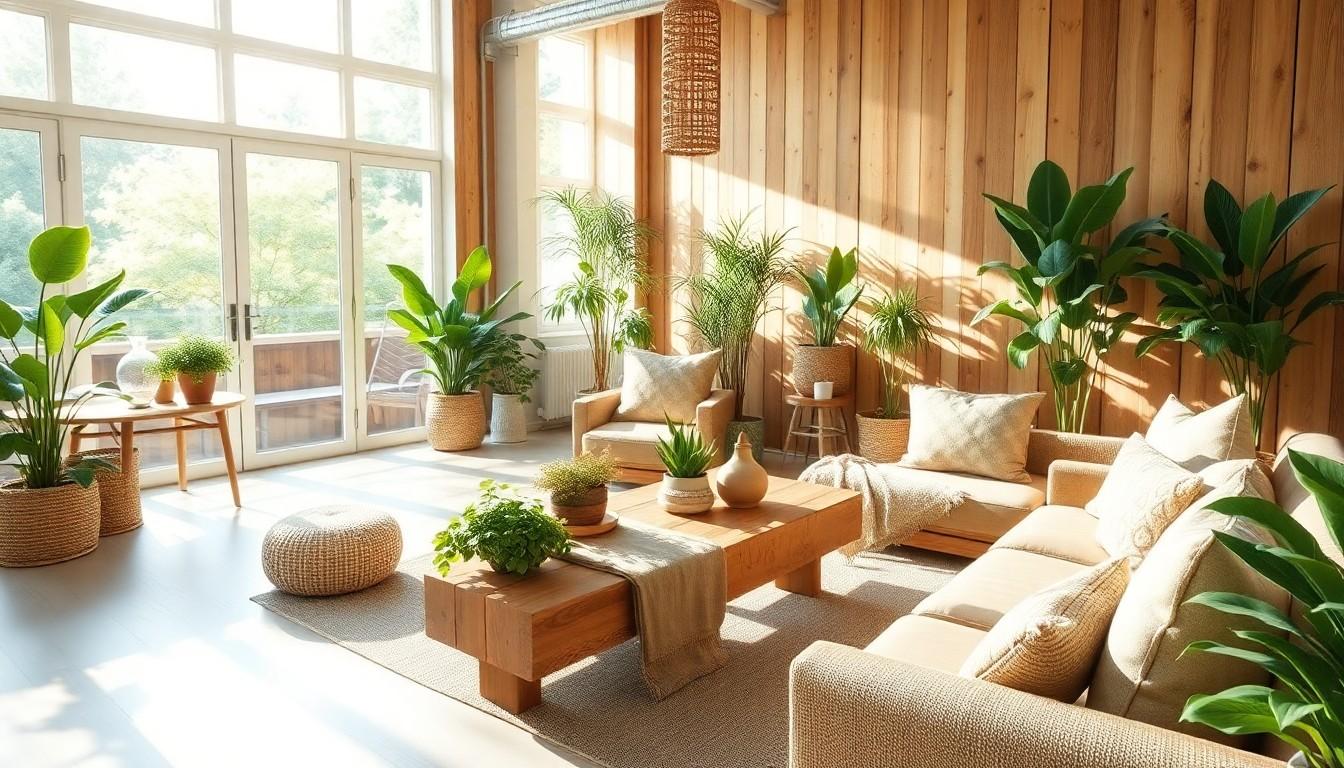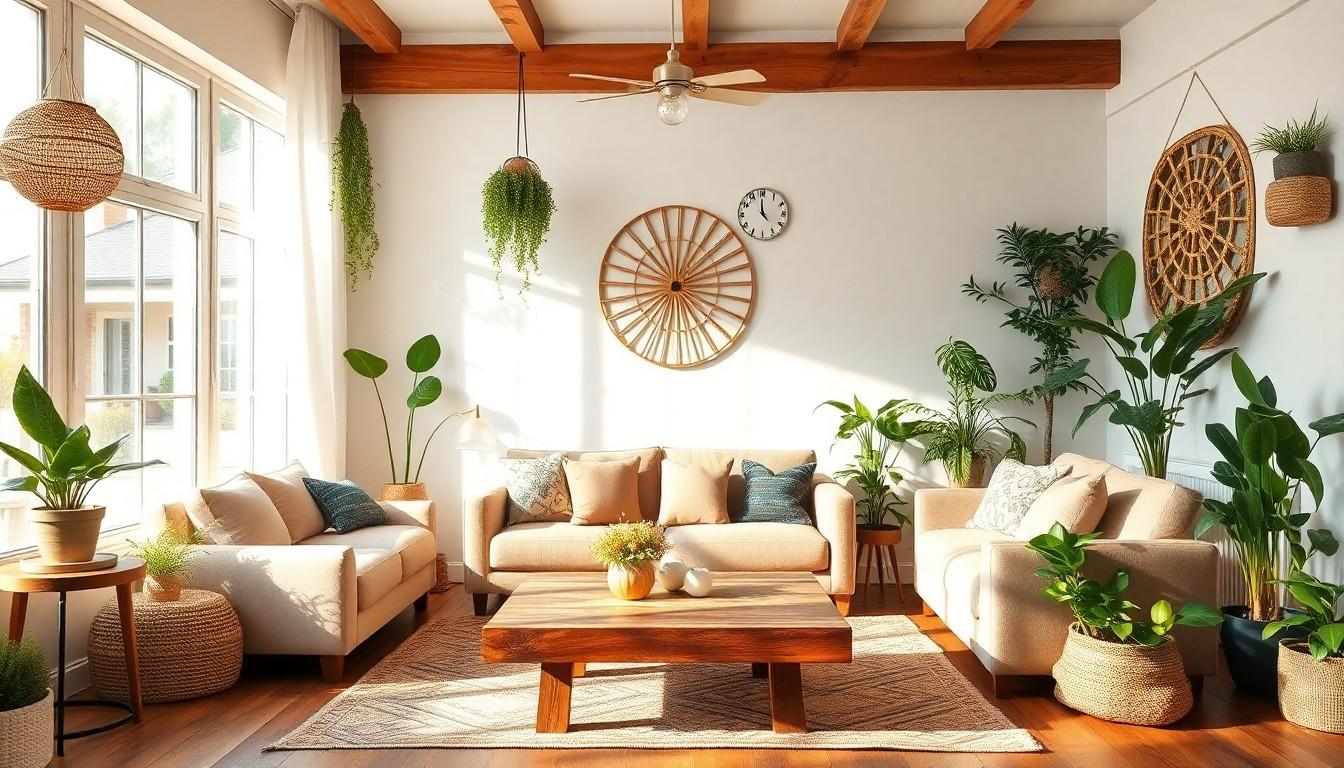Imagine walking into a home that feels as good as it looks—where every piece of decor not only tells a story but also plays nice with the planet. Eco-friendly home decor isn’t just a trend; it’s a lifestyle choice that transforms spaces into sustainable sanctuaries. Who knew saving the Earth could be so stylish?
eco-friendly home decor
Eco-friendly home decor represents a commitment to sustainability and environmental consciousness. This type of decor utilizes materials and practices that minimize harm to the planet. Items often include organic textiles, recycled materials, and non-toxic paints.
Decor choices prioritize renewable resources and energy-efficient appliances. By selecting furnishings made from bamboo or reclaimed wood, individuals contribute to reducing waste. Sustainable decor doesn’t sacrifice style; many options are visually appealing and unique.
Creativity plays a significant role in eco-friendly home decor. Upcycling old furniture or using vintage pieces fosters a distinctive look while keeping items out of landfills. Eco-friendly decor also involves choosing energy-efficient lighting solutions, such as LED bulbs, which reduce energy consumption.
In addition to materials, the lifecycle of products matters. Eco-friendly decor encompasses items designed for longevity, reducing the need for constant replacements. This approach encourages mindfulness about consumption and promotes quality over quantity.
A harmonious environment can be created through eco-friendly practices. Gardens with native plants conserve water and require less maintenance. Indoor air quality improves by incorporating plants known for filtering toxins, such as peace lilies or snake plants.
Living spaces benefit from eco-friendly choices both aesthetically and environmentally. Embracing this lifestyle leads to healthier homes and a smaller carbon footprint. Prioritizing sustainable practices often inspires others to explore eco-friendly decor options in their lives.
Benefits Of Eco-Friendly Home Decor

Eco-friendly home decor offers numerous advantages, making it an appealing choice for many homeowners. From promoting sustainability to enhancing health, its impact extends beyond aesthetics.
Sustainability
Sustainable home decor significantly reduces environmental harm. It encourages the use of materials sourced from renewable resources. Reclaimed wood, bamboo, and organic textiles minimize waste, demonstrating an effective alternative to conventional materials. By opting for ecologically responsible products, individuals contribute to conservation efforts. Eco-friendly decor often features energy-efficient appliances, which lower energy consumption. This shift reduces carbon footprints and supports sustainable manufacturing processes.
Health Benefits
Health improvements stem from eco-friendly decor choices. Non-toxic paints and finishes reduce harmful emissions, contributing to better indoor air quality. Sustainable textiles often lack synthetic chemicals, preventing allergic reactions for sensitive individuals. Plants incorporated into home decor naturally filter toxins and enhance oxygen levels. Consequently, living spaces become more inviting and healthier. Choosing eco-friendly items not only promotes well-being but also fosters a peaceful atmosphere. Improved indoor environments lead to enhanced mood and productivity, benefiting overall quality of life.
Types Of Eco-Friendly Home Decor
Eco-friendly home decor includes various styles and materials that prioritize sustainability and environmental responsibility. Individuals can enhance their living spaces while positively impacting the planet.
Recycled Materials
Recycled materials feature prominently in sustainable home decor. Furniture pieces made from reclaimed wood reflect a commitment to reducing waste and preserving resources. Items like glass bottles, metal scraps, and reclaimed textiles undergo transformation into unique home accessories. Many artisans design decorative pieces such as picture frames, vases, and light fixtures from recycled components. Each choice aligns with a moral responsibility to minimize landfill contributions while showcasing creativity. Embracing products made from recycled materials not only promotes aesthetic appeal but also embodies environmental consciousness.
Natural Fabrics
Natural fabrics play a crucial role in eco-friendly interior design. When opting for textiles, individuals often choose organic cotton, linen, wool, or hemp. Many of these fabrics come from sustainable farming practices, making them biodegradable and free from harmful chemicals. Upholstery and curtains made from these materials enhance indoor air quality by ensuring no toxic substances are released into living spaces. Choosing fabrics that are both durable and aesthetically pleasing contributes to a healthier home environment. Prioritizing natural fabrics fosters a connection to nature and encourages sustainable choices.
Energy-Efficient Lighting
Energy-efficient lighting solutions significantly reduce electricity consumption in eco-friendly homes. Options like LED bulbs consume up to 80% less energy than traditional incandescent bulbs, making them an excellent choice. Choosing fixtures that are designed for energy efficiency not only lowers energy bills but also reduces greenhouse gas emissions. Some modern designs incorporate solar-powered outdoor lighting, providing illumination while harnessing renewable energy. Creating inviting and well-lit spaces doesn’t compromise sustainability with energy-efficient lighting. Each installation reflects a responsible choice for both style and the environment.
Tips For Incorporating Eco-Friendly Home Decor
Incorporating eco-friendly home decor enhances aesthetics while supporting sustainability. Here are practical tips to get started.
DIY Projects
Creating eco-friendly decor through DIY projects promotes creativity. Upcycling old furniture transforms items into unique pieces. Customizing with non-toxic paints ensures safety and a personal touch. Reusing jars and bottles as decorative storage adds character and functionality. Experiment with natural materials, such as wood or stone, for a rustic ambiance. Designing planters from repurposed containers supports greenery and improves air quality.
Sourcing Sustainable Products
Discovering sustainable products involves prioritizing responsible sourcing. Seek out local artisans who use eco-friendly materials and ethical practices. Research brands committed to transparency in their production processes. Consider purchasing from companies that emphasize recycled materials and organic fabrics. Utilizing online marketplaces that specialize in sustainable goods simplifies the search. Attend local craft fairs and farmer’s markets to find unique, handmade items that support your eco-friendly goals.
Sustainability and beauty
Embracing eco-friendly home decor transforms living spaces into havens of sustainability and beauty. By choosing materials that are renewable and practices that reduce waste, individuals contribute to a healthier planet. The creativity involved in upcycling and sourcing unique pieces not only enhances aesthetics but also fosters a deeper connection to the environment.
With the added benefits of improved indoor air quality and a more peaceful atmosphere, eco-friendly decor choices support overall well-being. As more people adopt these practices, they inspire others to rethink their own decor decisions, creating a ripple effect that promotes sustainability. Making eco-conscious choices in home decor is not just a trend; it’s a meaningful lifestyle that enriches lives and protects the earth for future generations.

